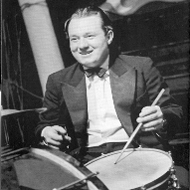In the context of the history of Czech music after World War II, the versatile personality of the composer Jan Rychlík meant almost the same as Charles Ives for the U.S.A. and Eric Satie for France, or the representatives of the Second Viennese School meant for the development of 20th-century musical thought. Rychlík was doubtless an experimenter but one who was "kind" to the audiences: his music is communicative and witty, his musical ideas variegated, and they did not even lack the sense of humour (rather a rarity in other 20th-century artistic music).
Jan Rychlík's road to a professional career in music was far from straight: having graduated from a Gymnasium in Prague in 1933, he decided to enter the School of Commerce, and started to study music more systematically only after the Czech universities and colleges were closed down by the Nazis during World War II. He entered the composition class of Jaroslav Rídký at the Prague Conservatory in 1940, and graduated in 1946. Rather than returning to commerce and economy, he chose the career of practical musician, playing the percussion in the orchestra of Karel Vlach, but being an equally skilful pianist and having also mastered other instruments. Initially, he composed popular music and film scores but gradually gravitated towards art music where, starting from the neoclassical style of expression, he eventually arrived at his personally-expressive style which could be classified as New Music. His music is particularly remarkable for the rich and rather complicated rhythmic structures, colourful instrumentation, an (almost Webern-like) brevity of form, as well as melodics which, he thought, was rather neglected in 20th-century music. He wrote his, predominantly chamber, compositions for unusual instrumentations, paying special attention to the wind instruments.
The most significant of his early chamber works are Suite for Wind Quintet (1946), Trio for Clarinet, Trumpet and Bassoon (1948), Études for English Horn and Piano (1953), Suite for 10 Instruments (1953), and Chamber Suite for String quartet (1954), as well as Four Partitas for Solo Flute, and Four Études for Solo Flute, both composed in 1954 and very popular with performers. Apart from historical reflections (chorale, Renaissance, Baroque) we can find in them modal elements, loose metrics, and hints of serial work.
His major compositions in which he definitively embarked on the path of New Music are Wind Quintet (1961) and particularly African Cycle for flute, oboe, clarinet, bassoon, 2 French horns, 2 trombones, and piano (1961-62), one of the most original Czech compositions of its time. In the application of the serial technique, African Cycle is evocative of the means of expression of the Second Viennese School but thanks to a balance between the rational and the emotional in the approach to compositional work, the piece is not devoid of directness and naturalness, and of the above-mentioned element of humour.
Other successful works of that period include Hommaggi gravicembalistici for harpsichord solo (1960) and two vocal compositions, namely Sneers for children's choir (1961) and Gallows Madrigals for mixed choir à cappella (1962). Relazioni for alto flute, English horn and bassoon ( 1963) are Jan Rychlík's last finished work, his most avant-garde composition, using apart from serialism also the principle of aleatorics, and particularly work with the tone colour, or timbre. His other output comprises 55 film scores, 8 incidental compositions, as well as many songs, and dance and jazz compositions.
When assessing the overall situation in Czech music in the late 1950s and early 1960s today, after a certain lapse of time, we have to state that Rychlík's contribution to it was one of a ground-breaker for he was inspired by stimuli which others used only sporadically. He did not merely adopt the compositional principles of New Music, he worked with them and developed them in his own creative way.
Rychlík was an innovator by nature which, combined with his versatile erudition (in the fields of literature, art, history and linguistics), enabled him to be active also as organiser and music critic. He initiated the setting up of Musica viva Pragensis, a New Music ensemble, contributed to the creation of an electronic studio in the country, wrote for the miscellany 'New Ways of Music', and also published his own books. Moderní instrumentace (published in 1968) was a major contribution to musical theory but due to Jan Rychlík's sudden death had to be finished by a team of musicologists headed by Jarmil Burghauser. Rychlík's other books that merit attention include Problémy a povery jazzu (Prejudices and Problems of Jazz), Dechové nástroje bez strojiva Valveless Brass Instruments), and his ethnomusicological studies, among others. Although an untimely death prevented Jan Rychlík from realising many of his other projects, he was certainly one of the most prominent personalities of Czech music in the 1950s and 1960s, a composer who reacted in a creative and perceptive way to the most varied stimuli of New Music but avoided the common trend toward modernity at all costs, and arrived at his own personallyexpressive style which is of interest to performers and audiences alike.

